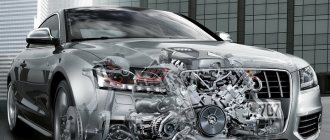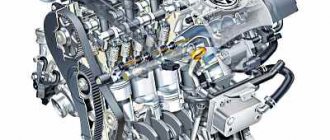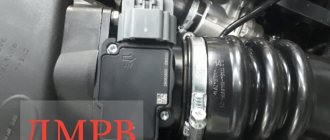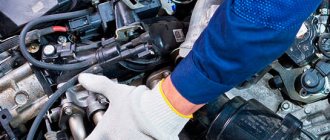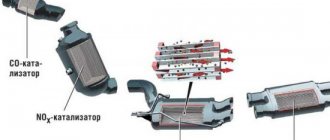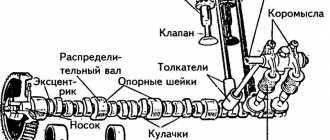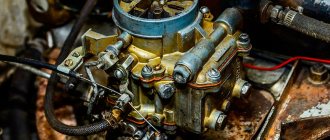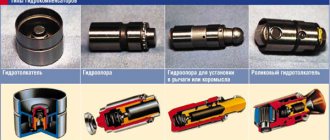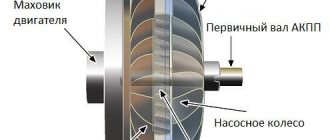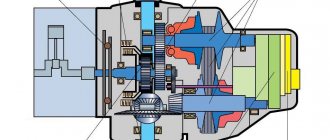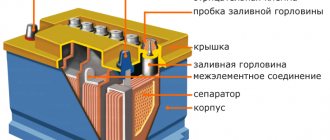A turbocharger is a device that allows you to increase engine power by approximately 30%, without the need to physically increase the volume of the cylinders. Such units are installed on almost all modern cars, regardless of the type of fuel used. Below we will tell you in more detail about the design and operation of a diesel engine turbine, and also outline the disadvantages of this device and the most common breakdowns.
Turbine design and features
The unit consists of two devices - a turbine and a compressor. The task of the first is to convert the energy of exhaust gases, and the second is to supply compressed air to the cylinders. “Impellers” are the main components of this system; they represent two bladed wheels (compressor and turbine).
At its core, a compressor is a pump; its only task is to supply compressed atmospheric air masses to the cylinders. Oxygen is necessary to burn fuel; the more it is supplied, the more the power unit can burn. As a result, this leads to a significant increase in engine power without physically increasing the volume or number of cylinders. The turbocharging system consists of the following components:
- compressor housing;
- bearing housing;
- compressor wheel;
- turbine wheel;
- rotor axis or shaft.
turbine housing;
In a turbocharger, the main element is the rotor, which is protected by a housing and attached to a special axis. Both the rotor itself and the turbine housing are made of heat-resistant alloys - this is necessary due to the fact that they are in constant contact with high-temperature gases.
The rotor and impeller rotate in different directions at high speed - this solution ensures that they are pressed tightly against each other. The operating principle is as follows:
- Exhaust gases enter the exhaust manifold.
- Then - into a special channel located in the supercharger housing, which is made in the shape of a snail.
- In the “snail” the gases are accelerated to high speed and supplied to the rotor.
Thanks to this principle, the rotation of the turbine is ensured. As for the turbocharger axis, it is mounted on special plain bearings and is lubricated by the flow of fluid from the engine compartment. Leakage of lubricant is prevented by the presence of a gasket and O-rings. In addition, mixed and separate flows of exhaust gases and air provide additional sealing. This technological solution does not provide a 100% guarantee that the exhaust will not enter the compressed air, but the system does not require this.
Turbine design
The turbine is based on a rotor (impeller), which is mounted on an axis and enclosed in a special housing. The constant contact of all turbine elements with hot gases necessitates the manufacture of the rotor and turbine housing from special heat-resistant materials.
The impeller and axle rotate in opposite directions at high frequencies, resulting in tight pressure of one element to the other. The exhaust gas flow penetrates the exhaust manifold, after which it ends up in a special channel. This channel is located in the turbocharger housing. The body has a peculiar snail shape. After passing the snail, the exhaust gases are accelerated and supplied to the rotor. This is how the turbine rotates.
The design of the device may differ on different types of diesel engines. The main difference is the different number of channels for the movement of exhaust gases in the housing. There may also additionally be solutions that allow you to control the flow of exhaust gases inside the housing (turbine with variable geometry), etc.
What else is included in the turbocharging system?
The turbine is a complex unit; it took engineers several decades to perfect the system. Only at first glance, the solution to compensate for efficiency losses using exhaust gases seems simple. Even after the creation of the device, it had certain problems for a long time.
For example, it was not possible to solve the problem of turbo lag - a delay after pressing the gas pedal and starting the rotor. The solution was found in the form of using two valves. One of them was used to remove excess air, and the second was intended for exhaust gases. In addition, modern turbines have a modified blade geometry, which seriously distinguishes them from similar devices of the second half of the 20th century.
One more problem can be identified, which was excessive detonation - modern engineers have also successfully dealt with this. The problem was that the temperature in the working sectors of the cylinders increased sharply during air injection, especially in the last stage of the stroke. The solution was found in installing an intercooler (air intercooler).
Intercooler is a device for cooling charge air. It performs two functions at once - it prevents detonation and prevents air density from decreasing. As a result, it was possible to maintain the functionality of the entire system.
It is also worth noting other important components of the turbine.
Control valve. Responsible for maintaining a given pressure level; excess pressure enters the exhaust pipe.
Bypass valve. It is used to remove excess air masses back into the intake pipes - this is necessary to reduce power when there is excess power.
Bleeding valve. If the throttle closes and there is no MAF sensor, the valve will return excess air back to the atmosphere.
Pipes. Sealed pipe sections. Some are used to supply air, the other to supply lubricating oil.
Exhaust manifolds. Must be compatible with turbocharger.
Air supply system on gasoline engines
Let us immediately note that we will not dwell on engines that are equipped with an outdated carburetor system. We will talk about an internal combustion engine with an injector. As an example, let's look at the general design of the air supply system on a car model with an injection engine.
We add that although the implementation scheme may differ slightly on different models of domestic and foreign production, the general principle and design remain the same.
The air supply system consists of the following basic elements:
- air intake;
- air filter in the housing;
- inlet pipe (inlet pipe pipe);
- throttle pipe;
- receiver;
The air intake on different cars is a plastic part through which atmospheric air is “sucked” into the engine. The element is usually installed in the engine compartment so as to take in air as the car moves; it is located in the area just below the headlights, closer to the radiator grille, on the right or left. This location allows you to effectively take in the required amount of air at different operating modes of the internal combustion engine.
An exception can be considered powerful SUVs and cars specially prepared for off-roading, in which the air intake is usually removed separately and vented outside. As a rule, in this case it is assumed that the car will overcome deep water obstacles, and the removal of the air intake allows one to avoid water hammer as a result of water entering the engine cylinders.
The next element is the air filter housing and the filter itself, which is installed inside it. Typically, on most cars, a housing with a filter is installed in the front part of the engine compartment; in addition, rubber support seals can be used under the housing. As for the filter, the filter element is usually paper, the filter surface area is maximized.
The air filter housing on many cars also contains an important electronic MAF sensor (mass air flow sensor). This sensor can also be located on other elements of the system up to the throttle valve.
The throttle pipe is attached to the receiver and meters the volume of air that is supplied to the intake pipe. The throttle valve, which is connected to the gas pedal using a special drive, is responsible for the amount of air entering the engine. On many modern vehicles, the gas pedal can be electronic, that is, it does not have a direct connection with the throttle assembly. In this case, after pressing the accelerator, a corresponding signal is sent to the electric motor that controls the throttle valve.
Let us also add that the throttle pipe also has in its design a TPS (throttle position sensor) and an IAC (idle air regulator). Thanks to the presence of the TPS, a signal is sent to the electronic engine control unit (ECU), through which the controller “understands” at what angle the damper is open. Based on signals from the mass air flow sensor, air metering sensor and a number of other sensors, the ECU adjusts the level of fuel supply to the cylinders through the injection nozzles in accordance with one or another operating mode of the internal combustion engine.
As for the IAC, this regulator is installed on the throttle body. In fact, this regulator is a stepper motor to which a conical valve stem is attached. Simply put, the IAC rod extends or, conversely, retracts due to the operation of a stepper motor. The control signal to the stepper motor is generated by the ECU.
This solution allows you to maintain and flexibly change the number of idle speeds when the throttle valve is closed, that is, the air bypasses. In other words, the IAC controls the amount of air that is supplied through a special channel, bypassing the closed throttle valve at idle.
Article on the topic: Why do you need a button in a car on which the car is drawn next to a hook or on a slope
When the valve stem extends completely, its conical part cuts off the air supply past the damper (the IAC valve is closed). When it opens, the amount of air increases, which increases in proportion to the degree of displacement of the rod from the seat. The total degree of movement of the rod directly depends on the number of steps that the stepper motor has performed.
If the engine is cold and idling, then the ECU “holds” high (warm-up) idle speeds until it warms up and reacts flexibly to any changing loads (turning on headlights, headlights, air conditioning, etc.) by raising the idle speed. This allows the motor to operate stably.
After the engine warms up, the controller reduces the amount of air supplied through the IAC and always strives to maintain a strictly defined crankshaft speed, however, on many cars, when the load changes in the IAC mode, the control unit is still able to briefly increase the speed.
We also note that when the driver turns off the ignition, the ECU first moves the IAC rod to the closed position, after which it slightly opens the valve by the required number of steps in order to create conditions in the form of sufficient air supply for the normal start of the unit at the time of restarting the internal combustion engine.
Principle of operation
First you need to understand two terms.
Turbo boost is a condition in which a rapidly rotating rotor increases the air supply to the cylinders, thereby increasing the power of the power unit.
Turbo lag is a short delay that occurs in the operation of the turbine when the amount of fuel supplied increases while the gas pedal is pressed. The delay appears due to the fact that the rotor needs some time until the gases accelerate it.
Turbocharging increases exhaust gas pressure due to more intense engine operation, but at the same time the boost pressure also increases. When critical values are reached, breakdown may occur, and therefore this process must be controlled. Valves are responsible for regulating the pressure, and the membrane and spring monitor the maximum permissible values. When a certain value is reached, the membrane opens a valve to relieve pressure.
Operation of a turbocharger on a diesel engine
The work is carried out according to the following scheme:
- The compressor pumps compressed atmospheric air.
- The air mass is mixed with fuel and enters the cylinders.
- The resulting fuel-air mixture ignites, which sets the pistons in motion.
- In parallel with this process, exhaust gases appear and are sent to the exhaust manifold.
- The gases accumulated in the housing significantly increase the speed.
- The rotation passes (along the shaft) to the compressor rotor, it draws in a new portion of air.
It turns out to be an interesting interaction. The rotor rotates faster - more air flows. The more air comes in, the faster the rotor rotates.
How does diesel engine turbocharging work?
The turbine rotor and the compressor impeller are rigidly mounted on the same shaft. Thus, the rotation speed of the rotor is transferred to the impeller. The circle closes:
- Through the compressor, air from the atmosphere, mixed with fuel, is supplied to the engine cylinders;
- The mixture burns, driving the pistons, and the resulting gases enter the exhaust manifold;
- Here they are received into the turbine housing, accelerated in the channel and at the exit interact with the rotor, causing it to rotate;
- The rotor transmits rotation through the shaft to the compressor impeller, which sucks atmospheric air into the housing.
An interconnected operating pattern is obtained, when the amount of intake air depends on the speed of rotation of the impeller and, conversely, the impeller rotates faster with a larger amount of intake air.
The principle of operation of turbocharging has two moments, called turbo lag and turbo boost.
The first moment is characterized by a delay in the operation of the turbine after increasing the fuel supply by pressing the gas pedal, since it takes time to accelerate the rotor with exhaust gases.
Following the turbo lag comes the moment of turbo boost, when the accelerated rotor sharply increases the air supply to the cylinders, increasing engine power.
Disadvantages of a turbine on a diesel engine
Like any device, the turbine has its own positive characteristics (which were described above) and disadvantages. The disadvantages include, first of all, increased fuel consumption, especially for incorrectly adjusted units. The second disadvantage is sensitivity to fuel quality, which is especially important in Russian conditions. The fact is that low-quality diesel can lead to detonation. Let's note other disadvantages:
- general increase in engine cost;
- increased demands on motor oil;
- oil and filters have to be changed more often (approximately every 5-6 thousand km);
- you need to change the air filter often;
- The turbine life of a diesel engine is significantly lower than that of a gasoline engine (due to higher exhaust temperatures);
- the average resource of the unit is 200-250 thousand km, after which it will require replacement or, at a minimum, major repairs;
- The repair is quite complex, and the average car owner will not be able to carry it out on his own.
However, it is worth noting that the pros still outweigh the cons. Otherwise, turbines would not be so popular.
The principle of operation of a diesel engine
The main feature of a diesel internal combustion engine is that the ignition of the fuel-air mixture in the combustion chambers occurs due to compression and heating. Diesel fuel is sprayed through nozzles.
Diesel fuel is supplied only at the moment at which the air is maximally compressed and has a maximum temperature.
When the air is hot, diesel fuel is highly flammable. Before fuel enters the combustion chambers of the internal combustion engine cylinders, it passes through cleaning filters that remove mechanical impurities that would quickly cause damage to the entire device.
Operating order of the diesel system:
- Air is supplied through the intake valve as the piston moves downward.
- Next, the piston rises up and compresses the air 20 times. The pressure at this moment is 40 kilograms per 1 centimeter. The air temperature at this moment reaches 500 degrees Celsius.
- When the air is compressed and heated, the injectors of this cylinder inject and atomize fuel. Due to the very hot air, diesel fuel ignites. This method of operation eliminates the presence of spark plugs in the system. Also, diesel units do not have an ignition system.
The process of self-ignition of diesel fuel with air from a glow plug.
Also, the device does not have a throttle valve, which ensures high torque. But, the speed at this time is at a low level. During one cycle of diesel operation, the injectors can supply fuel several times. - When the flammable mixture is ignited, the blast wave pushes the piston down. A piston that is connected to the crankshaft via a connecting rod and rotates the crankshaft.
- Next, from bottom dead center (BDC), the piston moves upward and pushes exhaust gases through the exhaust valves.
This process in engine operation is called a cycle.
Main malfunctions - signs and causes
It’s worth mentioning right away that the main cause of breakdowns is untimely maintenance of the unit; it is recommended to carry it out at least once a year. The next reason is low quality oil or untimely replacement. The third is the entry of foreign objects into the device (for example, small pebbles). Finally, the fourth is the banal wear and tear of individual turbine components, because each equipment has its own service life. Now we will describe the signs that may indicate a malfunction.
Black smoke from the exhaust pipe. The fuel burns in the intercooler or charge line. Most likely there is a malfunction of the control system.
Blue smoke. Perhaps due to a failure in the turbine seal, oil leaks into the combustion chamber.
White smoke. The oil drain line is dirty and will need to be cleaned.
Increased fuel consumption. Air does not reach the compressor.
Increased oil consumption. It is necessary to check the joints of the pipes - the tightness may be broken.
Reduced acceleration dynamics. Most likely, the control system failed, causing a lack of oxygen.
Extraneous whistling, grinding or noise. This could be a change in the rotor clearance, a defect in the housing, an air leak between the engine and the turbine, or contamination of the oil line.
You should always follow the operating rules of the unit - this will reduce the likelihood of breakdowns and extend the life of the device. You should follow a few simple rules:
- monitor the quality of fuel and oil;
- do not forget to change the oil and filters on time;
- start driving only after the engine has warmed up;
- After stopping movement, you need to let the engine idle, and not immediately turn it off.
And, of course, you should undergo regular maintenance.
What to do if the turbine breaks down
If a malfunction is detected, the first thing to do is carry out diagnostics. And the sooner the better. If you replace a faulty part in time, you will be able to avoid more serious problems. For example, often a car owner does not pay attention to a slight knocking, thinking that it does not matter; as a result, after some time he has to buy a new turbine, although initially a minor repair could have been done.
It should be noted that it is not enough to know how a diesel turbine works - you need to have a perfect understanding of all its components. Only with the appropriate skills, experience and equipment will it be possible to carry out high-quality repairs. That is why we recommend that you do not try to repair the unit yourself (you can only make it worse), but contact. We have been specializing in turbine repair since 1998, and therefore we know everything about them.
5 reasons to contact us:
- High-precision diagnostic equipment is available (Bosch and Delphi stands);
- The staff includes specialists with extensive practical experience in such work.
- Quick repairs within a day without loss of quality.
- We use only original components and repair kits.
- We provide an official guarantee on components and repairs performed.
At the first sign of a defect, contact us. We will determine the cause of the problem and offer an effective, cost-effective way to solve it.
DIY diesel engine turbine repair
To repair a turbine on a diesel engine, you must have all the necessary tools, parts, as well as extensive experience in performing complex repair work. Otherwise, it is recommended to go to a car service center.
If your car has a diesel engine, and you are going to carry out the repair yourself, but you have little experience, the result may be unsatisfactory. For example, sand will get inside the device, and eventually the turbine will completely break down. Therefore, you can carry out repairs yourself only if you are confident that you can handle it.
Before you start work, you need to acquire a repair kit. What you will have to purchase: liners, seals, screws, screws and washers. Also, for repairs you will need tools such as socket and open-end wrenches, screwdrivers, pliers with sliding jaws, a curly straightener, a puller and a mallet. With their help, you can repair a turbine on a diesel engine yourself.
If you are planning to make repairs on a car or truck, first of all you need to dismantle the turbine. How to do it:
- unscrew the bolts or remove the stoppers that secure the compressor and turbine casing;
- if the turbocharger has become stuck, hit the housing with a mallet;
- then we dismantle the snail.
Now let's start diagnosing the cartridge bearings. There should be no longitudinal play; a small transverse play is allowed. To remove the compressor retaining ring, use a pair of pliers. At this moment, the reverse side of the shaft should be fixed using a figured edit. When disassembling the mechanism, remember the left-hand thread on the shaft.
To remove the compressor wheel, you will need a puller. How to prevent it from becoming unbalanced? It is necessary to mount the parts in the correct position. Therefore, we put marks on the wheel and nuts.
Repairing a turbine on a diesel engine will be done correctly if you can thoroughly clean all the elements and make sure that they are not broken.
What parts can become unusable? First of all, these are bushings that quickly wear out, causing backlash in the cartridge. To repair the bushings, you will have to remove the retaining rings and then remove the mounting bolts. In addition, you need to replace the liners that are held in place by the stopper. Before removing the seal rings, carefully remove carbon deposits from the cartridge shaft and impeller.
Have you discovered that the shaft is worn out? Then the liners should be replaced. The shaft is ground to the repair size, then it is balanced. We noticed that there is wear only on the liners, so we install new parts of the appropriate size.
As soon as the repair is completed, we assemble the mechanism and mount it back. You should also make sure that the retaining rings are installed tightly enough on the cartridge. If they do not fit into their sockets, the turbocharger will become unusable.
Before reinstalling the bearings, bushings and oil rings, apply lubricant to them. This is the only way to prevent scuffing when starting the mechanism. Reassemble the turbocharger in reverse order. The force with which the fastening nut should be tightened is 5 Nm, but it is recommended to study the turbine operating instructions in advance. The mechanism is then installed on the motor and secured with screws and stoppers.
Note! Many inexperienced drivers make a common mistake when repairing a turbine on a diesel engine. There are special gaps between the body, bushing and shaft of the cartridge; they are filled with lubricant
These gaps are needed to compensate for the damping effect. A novice car enthusiast believes that this is too much play, so he mounts larger bushings in tension. All this leads to the fact that the rotor cannot rotate normally, the bushing quickly becomes unusable due to the damper effect and insufficient oil. As a result, the shaft becomes deformed.
In addition, it should be remembered that the mechanism must be balanced on a stand after repairing a turbine on a diesel engine. Of course, you can do the balancing yourself, but you must have experience in carrying out such work. If the mechanism is assembled incorrectly, the turbocharger will break, and the driver will have to spend a large sum to replace or restore it. It is for this reason that experts advise repairing a turbine on a diesel engine at a service station.
Diesel engine turbine design
A turbocharger is a solution that is installed on both gasoline and virtually every modern diesel car engine. Turbocharged engines are commonly called turbodiesels. This compressor is a kind of air pump that is driven by a turbine. The turbine of a diesel engine is rotated by the energy of exhaust gases.
The main task of the device is to pump air into the cylinders of a diesel internal combustion engine under pressure. The more air enters the combustion chamber, the more diesel fuel the diesel engine can burn. The result is a significant increase in engine power without the need to physically increase the volume of the cylinders.
Diesel engine air supply system
As you know, a modern diesel engine in various cars and special equipment is usually equipped with a turbocharger. This solution is also actively used on turbo-gasoline internal combustion engines.
In other words, to obtain the required output from the engines, the power plant is additionally turbocharged. A turbocharged diesel unit is called a turbodiesel. Let's look at the air supply diagram to such motors in more detail.
As in the case of gasoline internal combustion engines, the air supply system for diesel engines involves taking it from the atmosphere, cleaning the incoming air and further supplying it to the cylinders. In this case, the air additionally passes through the turbine, is cooled and then fed into the combustion chamber, and is pumped under pressure.
Using a turbodiesel as an example, it is worth highlighting the following elements of the air supply system:
- air intake;
- air cleaner (air filter);
- turbocharger;
- special air radiator (intercooler);
- intake manifold;
We have already become familiar with the function of the air intake and air filter when considering an atmospheric gasoline engine. As for turbo engines on special equipment that operates in conditions of heavy dust and general air pollution, a multi-stage cleaning system is used (two or even three-stage schemes). The design may include an inertial air pre-cleaner and other similar solutions.
So, after passing through the filters, the air is drawn into the turbocharger. After the turbine, the air flows through pipelines under pressure, passing through the so-called air radiator. The fact is that after compression in the turbine, the air heats up. Moreover, if it is cooled before being supplied to the cylinders, then the total mass of air increases.
As a result of this reduction in temperature, more air can be supplied to the combustion chamber, which allows for more complete and efficient combustion of fuel, achieving increased power, improved efficiency and reduced exhaust emissions.
Next, the compressed and cooled air enters the intake manifold, and then into the cylinders of the diesel engine. As for the turbocharger, this device uses the energy of the exhaust gases. Simply put, gases under pressure rotate the turbine wheel, and due to this rotation, the compressor wheel, which is mounted on the same shaft along with the turbine wheel, begins to rotate. Then the exhaust after the turbine enters the exhaust system of the vehicle and is released into the atmosphere.
Note that there are many types of turbines that differ in size, in their performance and may have a number of individual differences in the overall design of the device. Let us also add that for a long time the diesel engine did not have a throttle valve at all compared to its gasoline counterparts. In a nutshell, power in a diesel unit is regulated not by the amount of air supplied to the cylinders, but by the amount of fuel injected.
By the way, a throttle valve still appears on modern diesel internal combustion engines, but it performs other tasks. More precisely, exhaust toxicity is reduced in accordance with strict environmental standards.
Article on the topic: Why oil leaks from the gearbox: manual and automatic transmission
The throttle unit operates when the load on the engine is minimal, that is, the engine does not need a powerful flow of fresh air. At this moment, the damper partially blocks the air supply, and at the same time, the EGR exhaust gas recirculation valve is activated.
As a result, the remaining air is mixed with the exhaust gases, after which this mixture again enters the cylinders. Supplying exhaust with air reduces the temperature in the combustion chamber, resulting in a decrease in nitrogen oxide in the exhaust gases.
Operating principle and design of a diesel turbocharger
The turbocharger of a diesel engine consists of two wheels: turbine and compressor. These wheels can also be called an impeller. The turbine impeller is directly and rigidly connected to the compressor wheel via an axle. The supercharger device can be divided into main components:
- compressor housing (1);
- compressor wheel (2);
- rotor shaft or axis (3);
- turbine housing (4),
- turbine wheel(5);
- bearing housing;
Turbocharger axis
The axis is the central part of the turbocharger and is mounted inside the housing on plain bearings. The axle is lubricated by supplying engine oil from the engine lubrication system. Special O-rings and gaskets are installed on both sides.
These elements prevent excessive oil leaks so that lubricant does not get into the area where the compressor and turbine are located. Oil seals themselves do not provide a complete seal. These solutions are seals that operate due to the pressure difference that occurs during the operation of the turbocharger.
The seals also minimize the breakthrough of air from the compressor and gases from the turbine into the axle housing. It is worth noting that it is not possible to completely eliminate the ingress of exhaust and compressed air from the compressor. The excess is removed through the oil drain line along with the oil and ends up in the diesel engine crankcase.
Turbo lag and turbo boost
The turbine impeller and compressor wheel are mounted on one common axis. For this reason, a certain dependence is observed, which consists in an increase in the air supply by the compressor only with an increase in turbine speed. Experts distinguish the concept of turbojam (turbolag), which means a delay in the increase in diesel power when the accelerator is sharply pressed.
The turbine impeller is spun by exhaust gases to create effective boost pressure by the turbocharger. Under certain conditions, the turbine can rotate at a very high frequency, which depends on the design features of the device housing and the intensity of the exhaust gas flow.
Self-check of a diesel engine turbocharger. Checking the supercharger without removing it. Presence of oil in the turbine housing, shaft play, impeller.
When and why does it become necessary to adjust the turbocharger actuator. The principle of operation of the device, features and available methods for setting up the wastegate.
What determines the service life of a diesel engine turbocharger? Features and recommendations regarding the operation and repair of turbines with variable geometry.
Turbocharger design, main design elements, turbine selection. Advantages and disadvantages of turbocharged gasoline and diesel engines.
What is a supercharged engine and how does it differ from a naturally aspirated one? The main advantages and disadvantages of turbocharged internal combustion engines. Which motor to choose.
Selecting a mechanical supercharger or turbocharger. Design, main advantages and disadvantages of solutions, installation on an atmospheric tuning engine.
Why does a diesel turbine practically last forever?
If you compare a turbine on a gasoline engine and take the average mileage of 90,000-120,000 km. and a conventional turbine from a diesel engine with a mileage of 250,000 km, or even more. The operation of a turbine on gasoline and diesel is almost identical. The turbine has a hot part and a cold part. The hot part runs on the energy of the exhaust gases that come from the exhaust manifold and spins this part of the turbine. It is connected by a shaft to a cold compressor wheel which spins up to high speeds and forces air into the engine cylinders. Takes air from the environment. Due to this, we have more air-fuel mixture and the engine power increases.
So why do diesel turbines last longer?
- This is the exhaust temperature.
For gasoline it is 800-900 degrees Celsius, and for diesel it is 500-600 degrees Celsius. (This is on average.) Because the efficiency of a diesel engine is much greater and the energy from the burnt mixture goes into work, while in a gasoline engine it goes into heating. The higher the temperature of the exhaust gases, the more the turbine heats up and the oil that lubricates the bearings (bushings) can burn both in the channels and in the bearings. Therefore, lubrication of the turbine will be much worse and the turbine may completely coke and the oil will stop flowing. Oil not only lubricates but also removes excess heat. Since the exhaust temperature of a gasoline engine is higher, the turbine fails prematurely. But on a diesel engine, the exhaust temperature is lower and the turbine feels better. - Engine speed.
For gasoline, the engine runs at an average of 4000-6000 rpm. min. And diesel is on average 1500-2000 rpm. min. Accordingly, when a gasoline engine exhausts, more exhaust gases pass through the turbine and the turbine spins up faster. A diesel engine has lower revs, the exhaust is not as intense, and the turbine does not spin up as quickly as with gasoline. Fewer revolutions increase the life of the turbine. In a gasoline unit, the turbine develops 100,000-150,000 rpm. min. And diesel performance is much lower. On gasoline, valves are installed to relieve pressure so that the turbine does not rupture. Diesel engines also have them, but diesel engines operate at lower speeds. - Oil.
The base of gasoline and diesel oil is almost the same. But diesel runs on heavy fuel and produces a lot of sulfur during combustion. Sulfur is a solid substance and, when deposited on parts, acts as an abrasive. Therefore, appropriate powerful additives are added to diesel oil to remove sulfur and prevent it from settling on rubbing parts. But gasoline oil does not have such additives. This means that diesel oil lubricates the turbine better, removes oxidation and sulfur, does not burn, and removes heat. - Oil change intervals.
Diesel engines need to change oil more often. Approximately 5000-7000 km. On gasoline 8000-10000 km. This means that the oil on a diesel engine is cleaner and lubricates the turbine much better, and therefore the turbine runs longer on a diesel engine.
